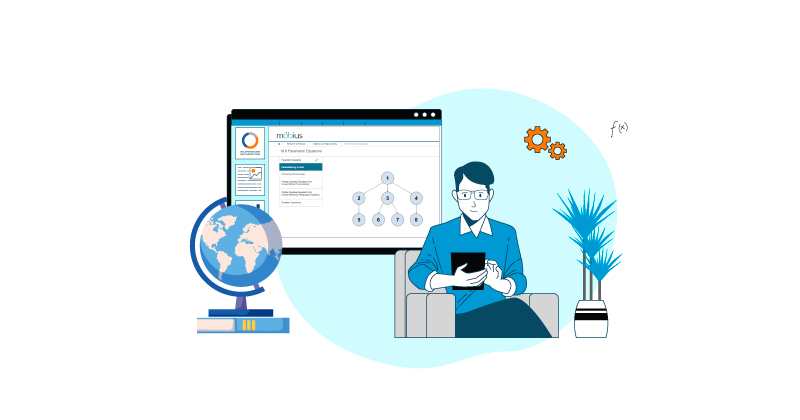Möbius STEM Learning: Bridging Theory to Real-World Application

Introduction
In the dynamic landscape of higher education, the pursuit of bridging theoretical concepts with practical applications stands as a cornerstone of pedagogical excellence.
“Möbius isn’t just a platform; it’s a gateway to a world where theory meets practice, and innovation knows no bounds.”
As we delve into the intricacies of Möbius STEM Learning, we uncover a wealth of features designed to empower educators and students alike in their quest for knowledge and mastery.
Read more: Möbius STEM Learning: Unlocking the Potential of India’s Future
Why Real-World Knowledge Matters in STEM Education
Imagine a student grappling with Newton’s Laws of Motion in a Physics class. Textbooks might explain the theories, but how does this knowledge translate to 21st-century workplace applications?
“True knowledge isn’t just about memorizing facts; it’s about understanding how those facts connect to the world around us.”
With Möbius STEM Learning, students can participate in interactive simulations — for instance, analyzing the forces acting on a car during acceleration or braking. This visualization brings abstract concepts to life simplifies STEM education.
Benefits of Real-World Knowledge in STEM
- Enhanced Student Engagement
- Abstract concepts in textbooks can often feel distant and irrelevant. Möbius bridges this gap by showcasing real-world applications, making the learning experience more engaging and relatable.
- Example: A student struggling with complex equations can explore simulations of bridge construction or earthquake resistance.
- Fostering Critical Thinking
- Real-world knowledge challenges students to apply theoretical understanding to practical problems.
- Example: Computer science students can analyze how algorithms work in traffic systems or weather prediction.
- Career Preparation
- The job market values problem-solvers. Möbius gives students the skills to translate knowledge into real-world solutions.
- Example: Chemistry students can explore material usage in technologies like solar panels or self-healing concrete.
- Closing the Equity Gap
- Möbius’ digital-first approach offers access to quality STEM education for students in remote or underserved communities.
Unveiling the Power of Möbius Classroom
1. Math in Action: Professor Mehta’s Calculus Class
Calculus can be abstract and intimidating. With Möbius, Professor Mehta uses interactive digital content to visualize concepts like derivatives and integrals.Students explore real-world applications — from analyzing projectile motion to optimizing business resources — making calculus both practical and engaging.
2. Physics in Motion: Professor Ghosh’s Class
Professor Ghosh transforms complex concepts in electricity and magnetism into immersive learning experiences. Students manipulate variables like generator speed or magnetic strength, observing electricity generation in real time. These simulations connect theory to real-world systems like power plants and appliances.
A Step-by-Step Guide to Real-World Knowledge with Möbius STEM Learning
Here’s a step-by-step approach educators can follow to integrate Möbius effectively:
1. Identify the Concept
Choose a theoretical topic you want to illustrate. Use your curriculum or learning objectives as a guide.
2. Explore Möbius Resources
Möbius offers a rich library of tools to enhance your lessons:
- Interactive Simulations – e.g., planetary motion, chemical reactions, circuit design
- Multimedia Content – 3D models, animations, diagrams, and videos
- Real-World Case Studies – e.g., robotics, renewable energy, medical technology
- Customizable Content Creation – Build your own assessments, quizzes, or activi
3. Design Engaging Activities
Use Möbius tools to promote active learning:
- Group Discussions – Analyze real-world scenarios
- Problem-Solving Exercises – Apply STEM concepts to practical issues
- Student Presentations – Let students present using Möbius simulations and visuals
4. Facilitate Online Assessments
Leverage Möbius’ assessment tools to drive student success:
- In-Line Questions – Check comprehension during lessons
- Algorithmic Questions – Dynamic, personalized questions to prevent copying
- Adaptive Assessments – Understand each student’s strengths and weaknesses
5. Continuous Improvement
Use Möbius analytics and student feedback to evaluate what works. Refine and evolve your lesson plans accordingly
Final Words
In conclusion, Möbius STEM Learning is more than just an e-learning platform; it’s a catalyst for change in STEM education. By empowering educators to integrate real-world applications, Möbius ignites a passion for learning, fosters critical thinking skills, and equips students with the tools they need to become future innovators. As the educational landscape continues to evolve, Möbius remains at the forefront, embracing new technologies and fostering a vibrant community of learners and educators dedicated to building a brighter future through a deeper understanding of STEM concepts.
Want to explore deeper? Book a Möbius demo today!